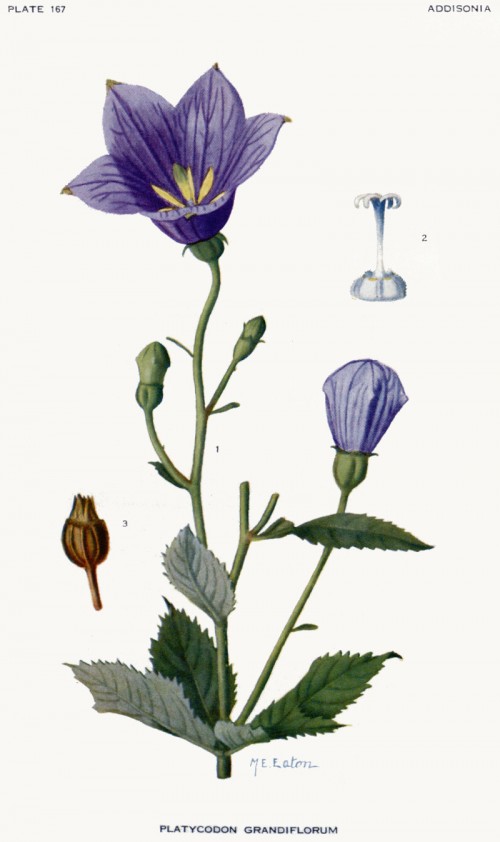Platycodon grandiflorus (Jacq.) A.DC. - (typo: Platycodon grandiflorum); syn. Campanula glauca Thunb.; Campanula grandiflora Jacq.; Platycodon glaucus - Campanulaceae
桔梗 jié gěng (chin.), 도라지 doraji (kor.), balloon flower, Chinese bellflower, Großblütige Ballonblume, Chinesische Glockenblume
Perennial herb, up to 120cm tall, native to Eastern Asia (China, Siberia, Korea, Japan), cultivated as ornamental and for food (roots); leaves simple, ovate, elliptic, or lanceolate, glabrous, abaxially glaucous, adaxially glabrous, serrate; flower buds balloon-shaped; calyx lobes triangular or narrowly triangular, sometimes toothlike; corolla bell-shaped, blue or purple (rarely pink or white).
http://www.efloras.org/florataxon.aspx?flora_id=2&taxon_id=200022990
The roots are edible and are used in herbal medicine to treat neuralgia and tonsillitis. It is regarded as analgesic and antipyretic, anti-inflammatory, and expectorant. https://ko.wikipedia.org/wiki/%EB%8F%84%EB%9D%BC%EC%A7%80
„The extracts from Platycodon grandiflorum have been reported to have a wide range of health benefits. In particular, in Korea, the roots grown for 4 years have been used to treat bronchitis, asthma, pulmonary tuberculosis, diabetes and inflammatory diseases… the crude petroleum ether extract from Platycodon grandiflorum exhibited strong inhibitory activity against human cancer cell growth… the antioxidant active and probably phenolic compound in this study has a high activity, which is comparable to BHA. Their MTT [ 3-(4,5-Dimethylthiazol-2-yl)-2,5-diphenyltetrazoliumbromide] assay revealed that Platycodon grandiflorum also contains a strong polyacetylenic anticancer compound, which exhibited cytotoxicity on the three human cancer cell lines.“
[Antioxidant and anticancer activities of organic extracts from Platycodon grandiflorum A. De Candolle roots., Lee, J.Y., Hwang, W.I., Lim, S.T., Journal of Ethnopharmacology, 93(2), 2004, 409-415] http://foodchem.net/publication/files/2004-03-03.pdf
„The root of P.grandiflorus, radix platycodi, has been consumed as a food and has been used as a folk remedy for conditions such as coughing, the common cold, bronchitis, asthma, pulmonary tuberculosis and inflammation. Radix platycodi is abundant in saponins. Several studies have reported that various platycodon saponins exhibit strong anti-inflammatory activity by blocking the generation of pro-inflammatory mediators and cytokines through the inhibition of nuclear factor-κB (NF-κB) and/or mitogen-activated protein kinase (MAPK)… The present results demonstrate that PGS [Radix Platycodi saponins] significantly exhibits anti-inflammatory activities via the attenuation of pro-inflammatory factors in LPS-treated BV2 microglial cells. The inhibitory effects were also mediated through the inhibition of the NF-κB, PI3K/AKT and MAPK signaling pathways. Therefore, on the basis of the anti-inflammatory effects of PGS, P. grandiflorus may be a possible therapeutic candidate for the treatment of neurodegenerative diseases.“
[Anti-inflammatory effects of saponins derived from the roots of Platycodon grandiflorus in lipopolysaccharide‑stimulated BV2 microglial cells., Jang, K.J., Kim, H.K., Han, M.H., Oh, Y.N., Yoon, H.M., Chung, Y.H., Choi, Y.H., International journal of molecular medicine, 31(6), 2013, 1357-1366 http://www.spandidos-publications.com/ijmm/31/6/1357?text=fulltext
Platycodin D, the main active saponin of Platycodon grandiflorum, was isolated from the aerial parts. Its protective effect „ …was evaluated by tracking biochemical markers, enzymatic antioxidants and proinflammatory cytokines in serum and liver tissue. The results indicated that PD pretreatment significantly decreased the levels of triglyceride (TG), total cholesterol (TC), low density lipoprotein cholesterol (L-DLC) in serum and malondialdehyde (MDA) in liver. PD was also found to increase the activities of catalase (CAT), superoxide dismutase (SOD), and glutathione peroxidase (GSH-Px) in the liver (p < 0.05). In addition, PD markedly decreased the levels of proinflammatory cytokines, including tumor necrosis factor-α (TNF-α), interleukin (IL)-1β, and IL-6, which was caused by alcohol exposure (p < 0.05). In contrast, histopathological examinations revealed that PD pretreatment noticeably prevented alcohol-induced hepatocyte apoptosis and steatosis. Collectively, the present study clearly suggests that the protective effect exhibited by PD on alcohol-induced liver oxidative injury may occur via the alleviation of oxidative stress and inflammatory response.“
[Platycodin D isolated from the aerial parts of Platycodon grandiflorum protects alcohol-induced liver injury in mice., Li, W., Liu, Y., Wang, Z., Han, Y., Tian, Y.H., Zhang, G.S., Wang, Y.P., Food Funct., 6(5), 2015, 1418-1427]

Addisonia, vol.5, t.167 (1920) [M.E.Eaton]
http://plantgenera.org/species.php?id_species=806143